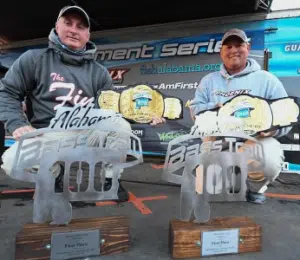WE ARE YOUR SOURCE FOR FISHING DESTINATIONS IN ALABAMA!
Mastering the Spawn: Jim Leary's Guide to Success on Guntersville.

Make the most of your spring fishing adventures on Lake Guntersville with Jim Leary’s tips for finding and catching spawning largemouth bass.
By Eileen Davis
Anglers have an opportunity to catch trophy-class largemouth bass during the spawn on Lake Guntersville. By targeting specific areas and using proven techniques, veteran guide and winning tournament angler Jim Leary consistently puts clients on quality fish during this prime period. On a good day in spring, Leary reports anglers can catch multiple four-pound fish with the chance of landing a true giant.
“Lake Guntersville is a top-tier largemouth bass fishery largely because of its vegetation,” Leary said. “Hydrilla is dominant, and for the past decade, we’ve also had eelgrass. While eelgrass can be a nuisance, fish relate to it in the winter. Milfoil has been scarce lately, leaving hydrilla as the primary cover. Hyrilla grows a depths of six to eight feet, and eel grass grows in water one to four feet deep.”
Leary reports the spawn can begin as early as mid-March, triggered by a string of warm days. The key factor is morning water temperature reaching 58–60°F, which signals the spawn is in full swing.
“Weather plays a huge role,” Leary said. “We had a bass virus in 2016 that changed things for a while, but this past week, the fishing has been as good as it was in 2014 or 2015. The average fish weighs about four pounds.”
Finding Spawning Bass
The early spawn targets protected, shallow areas with the north and northwest pockets warming first. In these pockets, look for firm bottoms like sand, gravel or small rocks. These substrates help anchor the eggs and prevent them from being washed away. Submerged grasses, lilly pads, blowdowns and stumps offer additional protection for spawning.
“Some bass also spawn on hard rock areas close to the river, not necessarily on a river ledge but on bars, humps, or long flat points that sit 100 to 200 yards from the main river channel,” Leary said. “These areas offer stability for beds and protection from strong current, making them prime spawning locations.”
Interestingly, Leary notes that the best spawning areas change annually based on grass conditions. “Bass spawn in all creeks, but there is always one creek the produces best. It feels like they hold a meeting and decide to spawn in a different creek each year!”
Offering protection from cold winds, creeks like Honeycomb, North Saulty, Mud, and Crow are prime areas. Honeycomb, in particular, has deep, clear water leading to ideal spawning flats.
Water clarity also dictates where bass will spawn. In dingy water, which warms faster, bass select structure like stumps and laydowns that hold heat. As waters clear, bass may move to slightly deeper areas, creating beds in tall grass.
“Grass provides security and protects eggs from current and predators like bluegill,” Leary explained. “Bass will use hydrilla and other cover to guard their nests.”
Productive Baits and Techniques
Leary’s go-to lure for bedding bass is a weightless Yamamoto Senko rigged wacky-style with a size 2 Gamakatsu circle hook. He uses a tool to roll a rubber band onto the middle of the Senko, which secures the hook.
“The slow fall of the Senko makes bass think it’s a bluegill hovering around their bed,” Leary said. “It has a subtle shimmy on the drop, which triggers reaction bites. To fish it, I let it fall to the bottom, lift it slightly, then let it fall again, working it slowly back to the boat. It’s a patient technique but highly effective.”
His setup includes a spinning rod with 30-pound braid and a 14-pound Sunline Sniper fluorocarbon leader tied with an Alberto knot. The fluorocarbon offers stealth while the braid provides strength.
Another Leary favorite is a Texas-rigged Baby Brush Hog. “It has tentacles that wiggle, which bass can’t resist,” he said. “You can drag the Baby Brush Hog across shell beds and stump flats without getting frequent hang-ups.” Leary rigs the creature bait on a 4/0 Gamakatsu Superline hook, with a 3/16-ounce weight.
When bass first move shallow, a buzzbait can produce explosive strikes, especially from larger fish. Leary adds either a Horny Toad or a Ribbit to his buzzbait for added casting distance and resistance, allowing slower retrieves while maintaining surface disturbance.
A hollow-body frog fished next to primrose is another productive option. “The trick is to let it sit still and wait for the bass to take it,” Leary explained. “This do-nothing approach is a proven way to catch five-pounders. Casting parallel to the vegetation and using subtle twitches followed by pauses can also trigger strikes.
For color selection, Leary prefers black buzzbaits, “bream color” frogs with red, yellow, and white bellies, and green pumpkin or watermelon red Senkos.
Finding Trophy Fish
While there’s no guaranteed method for targeting only large bass, Leary has found success sight-fishing in clear water by looking for large white circles on the lake bottom—clear signs of beds.
“I’ve seen and caught giants this way, including fish over 10 pounds,” Leary said. For pressured bass, he finds the wacky-rigged Senko produces more bites than anything else.
A common mistake anglers make is rushing their presentation. “A lot of people get in a hurry,” Leary noted. “They also don’t set the hook immediately when they get a strike. Many anglers think they’re fishing slow, but they’re not going slow enough.”
For those new to Lake Guntersville or short on time, Leary suggests hiring a guide for the first day. “I get a lot of last-minute calls from guys saying, ‘Tomorrow’s my last day here, and I haven’t caught any fish.’ A guide can help you figure things out fast.”
His final tip: “Early in the season, the creek arms on the north and northwest parts of the lake warm up first. Surface temperature is everything when it comes to finding active bass.”
To book a guide trip with Jim Leary, visit his website: https://www.guntersvillebassguides.com/
Jim Leary’s gear for catching largemouth bass.
No extra cost to you — but if you buy through these links, it supports FishingBama. As an Amazon Associate, I earn from qualifying purchases.
Yamamoto Senko: https://amzn.to/424Kmsf (Amazon)
Zoom Baby Brush Hog: https://amzn.to/4iSDZ2c (Amazon)
Lew’s, KVD Toad Buzz Lure: https://amzn.to/4i5SfUt (Amazon)
BOOYAH Hollow Body Frog: https://amzn.to/4iSEF7K (Amazon)
Zoom Bait Horny Toad: https://amzn.to/4iW7AHG (Amazon)
Ribbit Frog: https://amzn.to/3DTEGJt (Amazon)
14-Pound SUNLINE Fluorocarbon Line Shooter, Snipe: https://amzn.to/4iEbBAT (Amazon)
30-Pound Sunline SX1 Braid: https://amzn.to/42fuT9Y (Amazon)
4/0 Gamakatsu Super Line EWG Hook: https://amzn.to/4hJRAHR (Amazon)
Size 2 Gamakatsu Octopus Circle Hooks: https://amzn.to/4c4LSz7 (Amazon)
7’4″ Duckett Fishing Wheeler Select Series Casting Rod for Brush Hog: https://amzn.to/3RllKGE (Amazon)
7’1″ Duckett Fishing Wheeler Select Series Casting Rod for frogs: https://amzn.to/41MpxTE (Amazon)
7’1″ Duckett Fishing Wheeler Select Series Spinning Rod for wacky: https://amzn.to/43r3hjf (Amazon)
Lowrance ActiveTarget2: https://amzn.to/4jP64Iq (Amazon)
Lowrance HDS PRO Fish Finder: https://amzn.to/4367gQj (Amazon)
Click here to read more about how successful anglers find and catch Bama’s bass.
PLEASE SHARE
